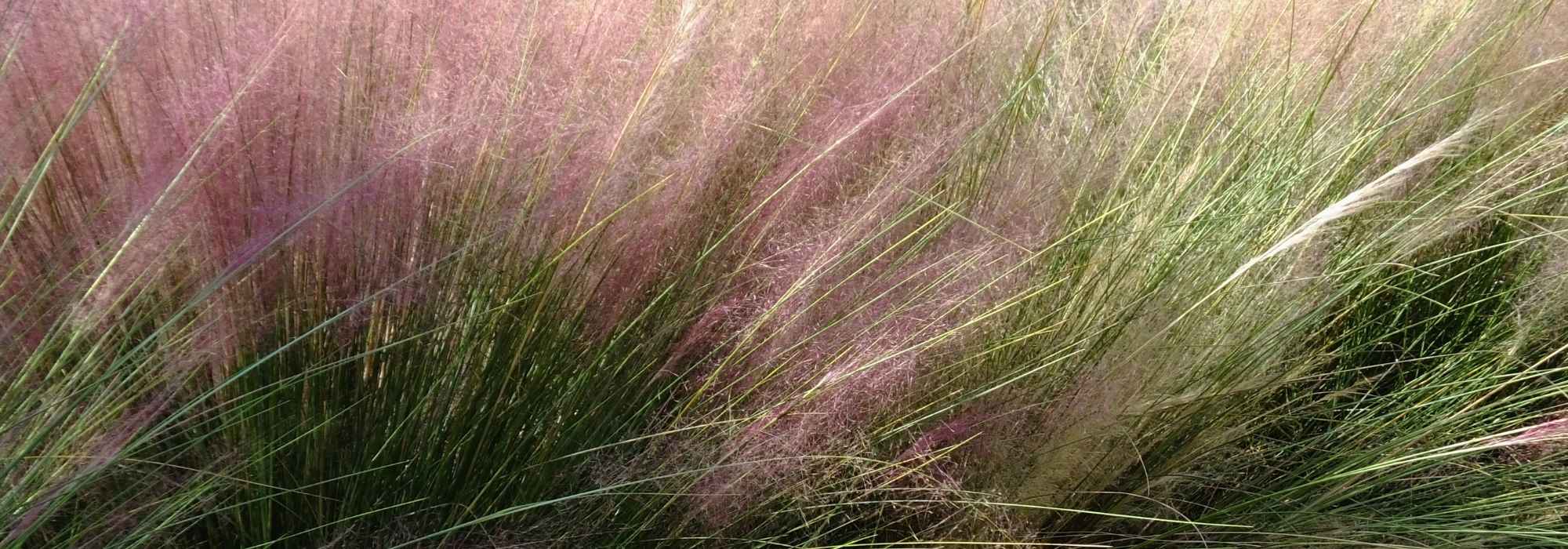
Muhlenbergia: planting, growing and caring
Contents
Muhlenbergias in a nutshell
- Muhlenbergia prefer a position in full sun and well-drained soil
- Their often pink, airy flowering appears in autumn, from September to November
- Their blue-green foliage takes on golden hues in autumn
- Minimal maintenance is sufficient, with light pruning at the end of winter
- They are drought-resistant and tolerate poor soils
The word from our expert
The Muhlenbergia, particularly Muhlenbergia capillaris, are essential ornamental grasses for adding lightness and elegance to gardens. What sets them apart is their airy and spectacular flowering, with bright pink inflorescences appearing in autumn, typically from September to November. Beyond their beauty, they are very easy to grow: they prefer full sun and dry, well-drained soil, and they tolerate challenging conditions like drought and poor soils.
The foliage, blue-green in summer, turns stunning golden hues in autumn, enhancing their appeal. In terms of maintenance, these plants require very little attention. A simple pruning in late winter to tidy up dry leaves is all that’s needed. They can be propagated by sowing or division, making them easy to reproduce as well. In short, Muhlenbergia are perfect for modern borders, meadow gardens, or dry spaces, and they create natural, light-filled atmospheres with incredible visual impact.
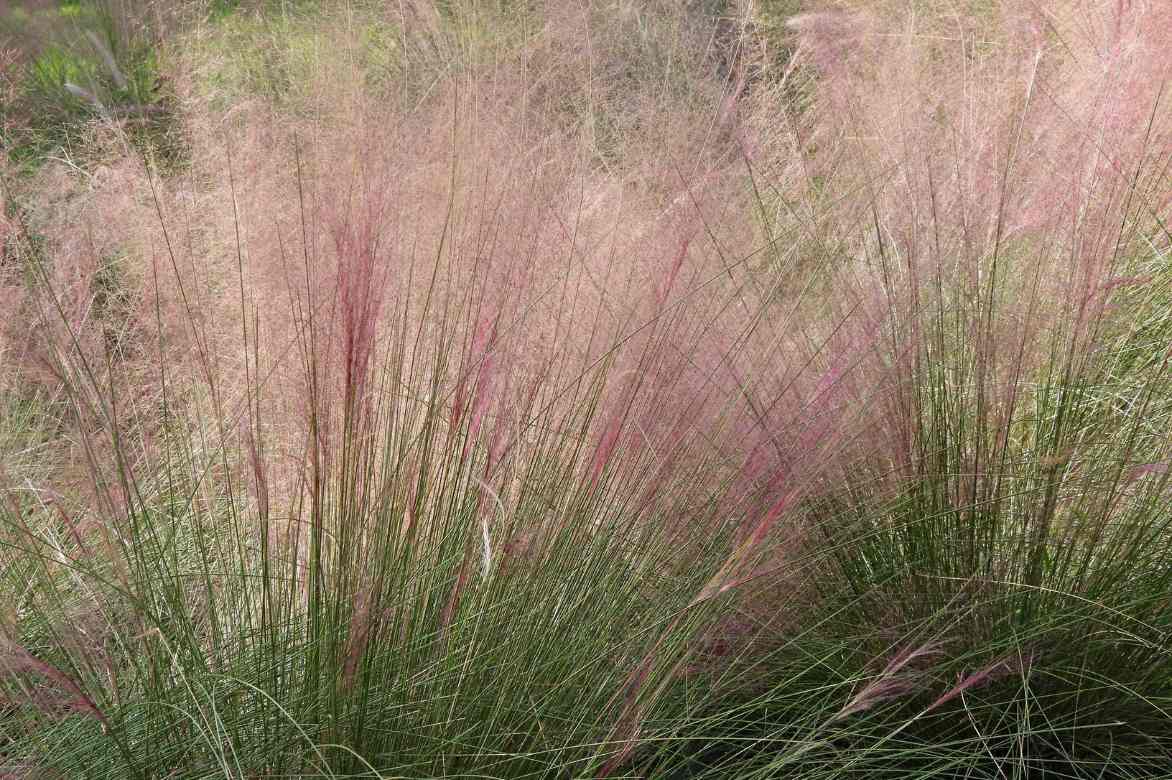
Muhlenbergia capillaris
Botany and description
Botanical data
- Latin name Muhlenbergia sp.
- Family Poaceae
- Common name Muhly grass
- Flowering September to November
- Height 1 m
- Exposure sun
- Soil type calcareous and well-drained, even poor
- Hardiness -18°C
The genus Muhlenbergia belongs to the Poaceae family (grasses) and was named in honour of the American botanist of German origin Gotthilf Heinrich Ernst Muhlenberg (1753–1815), who made significant contributions to plant classification in North America. Muhlenbergia species are primarily native to North and Central America, but some are also found in Asia. They are mainly found in arid or semi-arid regions such as dry prairies, savannas, scrub vegetation, and rocky areas. However, some species also thrive in slightly more humid environments, such as riverbanks and mountain slopes.
There are approximately 170 species of Muhlenbergia, with the most well-known and commonly cultivated being:
- Muhlenbergia capillaris (Pink Muhly Grass): the most popular for its airy pink inflorescences.
- Muhlenbergia rigens (Deer Grass): stiffer, with golden tones, it is adapted to drier environments.
- Muhlenbergia lindheimeri: a bluish grass with silvery spikes, widely used in landscape gardening.
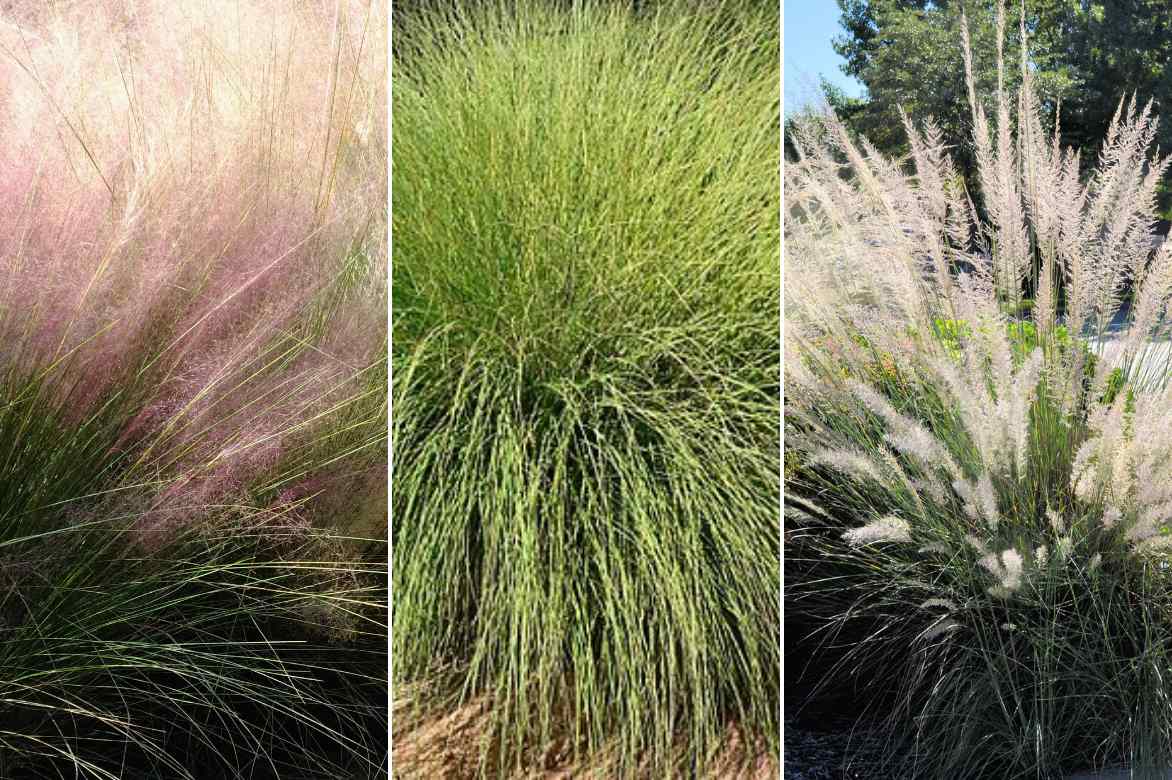
Muhlenbergia capillaris, Muhlenbergia rigens (photo Wikimedia Commons – Stan Shebs), and Muhlenbergia lindheimeri
The habit of Muhlenbergia is graceful and upright. These grasses form dense, upright clumps, often creating rounded tufts. The height of the plant varies by species, ranging from 60 cm to 1.20 m on average. The soft, light foliage and panicles give them a very airy and elegant appearance, perfect for adding movement to the garden, especially when swayed by the wind.
Muhlenbergia has a fibrous and dense root system. These running roots allow the plant to anchor firmly in poor, dry soils. Their roots are well adapted to arid environments, enabling them to quickly absorb water after rainfall. This system contributes to their resilience in drought conditions.
The foliage of Muhlenbergia is one of its main decorative features. The leaves are long, slender, and ribbon-like, ranging from 30 to 90 cm in length depending on the species. Their texture is generally soft, slightly rough to the touch. In terms of colour, they display shades from green to blue-green, sometimes with silvery highlights. In autumn, they turn golden or brown, enhancing their ornamental appeal. Moreover, most species are evergreen, retaining their foliage year-round and providing visual interest even in winter.
The inflorescences of Muhlenbergia are often spectacular and airy, appearing as delicate, wispy panicles. The floral spikes, extremely fine and almost thread-like, add a unique visual lightness. The colours vary by species, ranging from bright pink in Muhlenbergia capillaris to silvery or golden hues in M. rigens and M. lindheimeri. Flowering occurs in late summer and early autumn, creating a beautiful misty effect that adds movement to the garden. The flowers, small and discreet, are clustered in tight spikes, but it is the fineness and elegance of the inflorescences that capture attention, especially when present in large numbers.
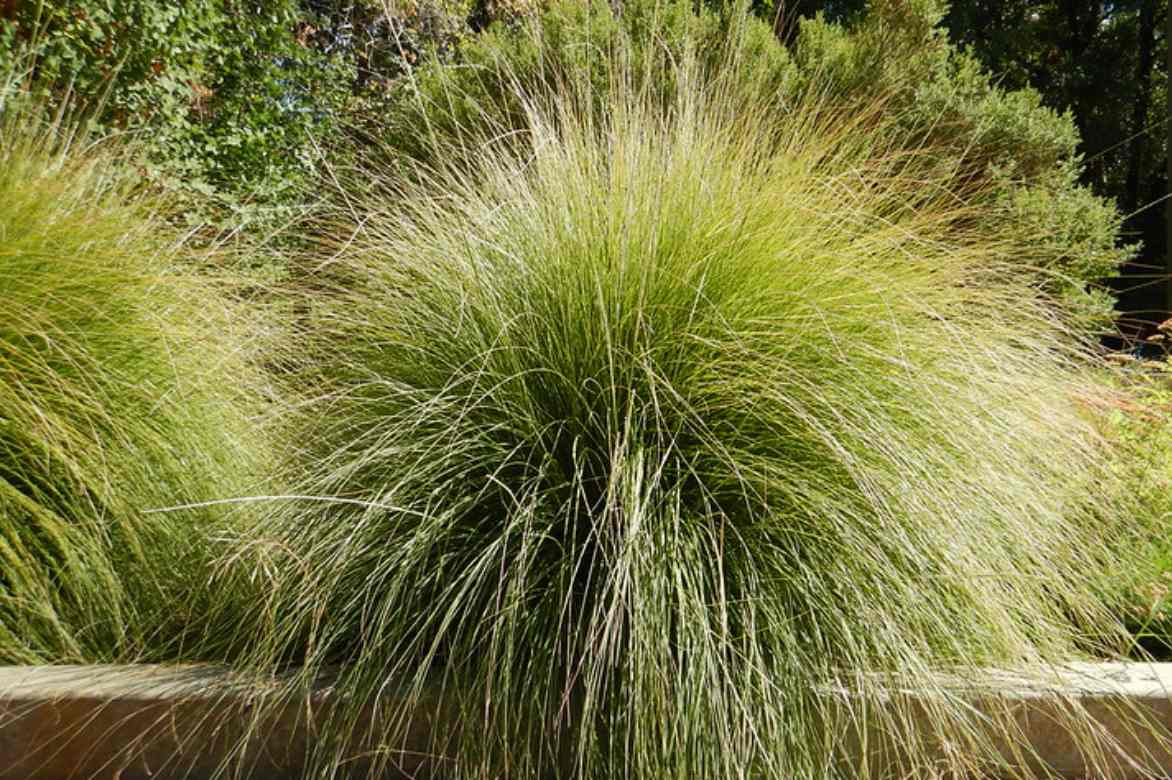
Muhlenbergia rigens (photo Matt Lavin)
Our favourite varieties
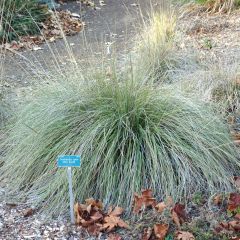
Muhlenbergia rigens
- Flowering time October to December
- Height at maturity 1,50 m
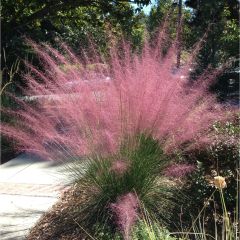
Muhlenbergia capillaris
- Flowering time October to December
- Height at maturity 1 m
Planting a Muhlenbergia
When to Plant?
The best time to plant a Muhlenbergia is in spring or autumn, when temperatures are mild and the soil is still moist. This allows the roots to establish well before periods of intense heat or cold. Avoid planting in summer, as drought and heat could stress the plant before it becomes well-rooted.
Where to Plant?
Muhlenbergia thrives in sunny locations, ideal for promoting abundant flowering and dense foliage. They can tolerate light partial shade, but too much shade may limit their flowering and reduce the plant’s aesthetic appeal.
Muhlenbergia is highly tolerant of poor soils, making it adaptable to many situations. It grows well in dry to moderately dry soils, with good drainage. The ideal soil should be slightly sandy or gravelly, with excellent drainage. They cannot tolerate waterlogged soils, as this may cause root rot. They also tolerate some salinity, making them suitable for coastal gardens.
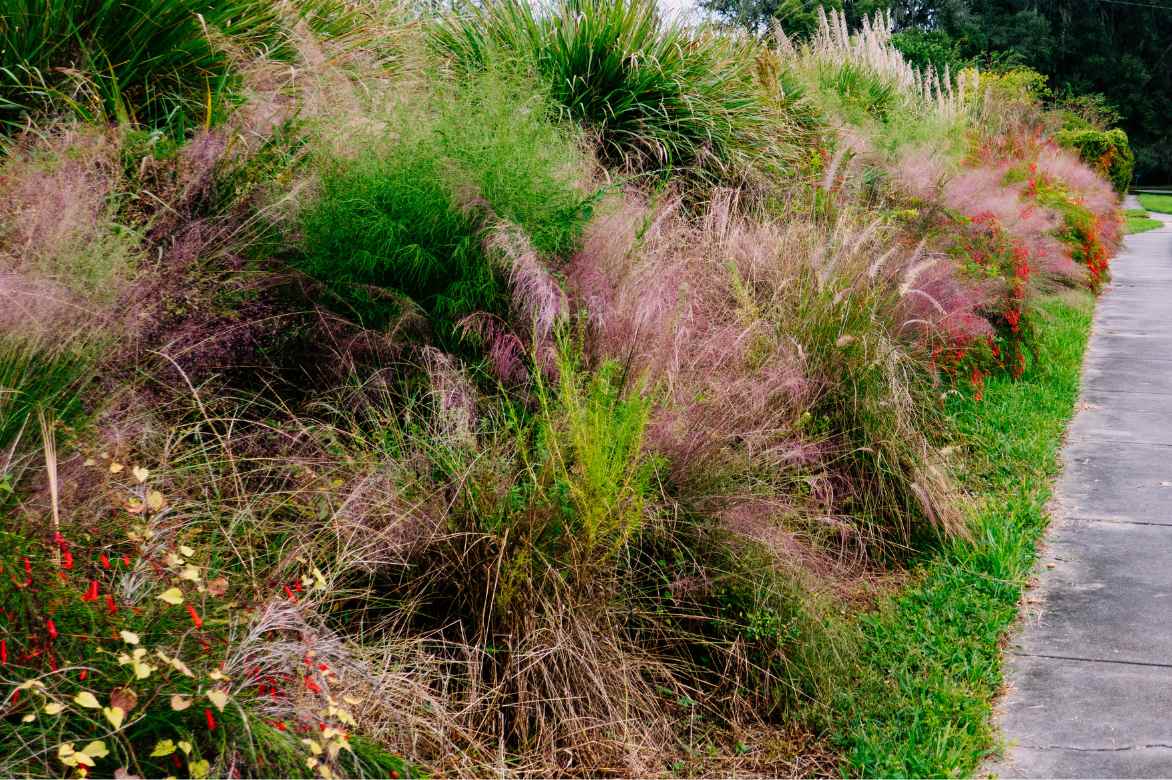
A lush flowerbed, where Muhlenbergia mingles with other grasses
How to Plant Muhlenbergia?
In the Ground
- Soil preparation: Loosen the soil to a depth of about 20-30 cm to allow for good root development. If your soil is heavy or clayey, add gravel to improve drainage.
- Spacing: Plant your Muhlenbergia with a spacing of 50 to 60 cm between each young plant. This allows the plant to spread and avoids excessive competition between roots.
- Planting: Dig a hole twice as wide as the root ball and of equal depth. Place the plant in the hole and fill it with a mix of compost and garden soil. Lightly firm the soil and water thoroughly after planting.
- Watering: Water regularly for the first few weeks to aid root establishment, especially if planting in spring. Subsequently, Muhlenbergia is highly drought-resistant and requires little watering.
- Mulching: To suppress weeds and retain moisture, add a layer of mulch around the base, without smothering the plant’s crown.
In Pots
Muhlenbergia adapts well to container gardening. Choose a pot 30 to 40 cm deep and wide for smaller species like Muhlenbergia capillaris, or 50 cm for larger ones like M. lindheimeri. Opt for terracotta pots for better soil aeration, or resin pots for their lightweight. Ensure there are drainage holes and add gravel or clay pebbles at the bottom to prevent waterlogging.
Use a universal potting mix or Mediterranean plant compost, adding 30% sand or pumice to improve drainage. Also, mix in some garden soil with light compost to enrich the substrate without making it too compact.
Muhlenbergia has a dense root system, so it can remain in the same pot for a few years. However, after 2 to 3 years, it is recommended to repot the plant to refresh the substrate and provide more space for the roots. Choose a slightly larger pot at this stage.
Maintenance and Pruning of Muhlenbergia
Watering
- First year: water regularly after planting to encourage good root establishment, especially during dry spells.
- Subsequently: once well established, the Muhlenbergia is drought-resistant. In pots, monitor the substrate’s moisture more frequently.
Fertiliser
The Muhlenbergia does not require fertiliser. A compost application at the beginning of spring is sufficient.
Pruning
At the end of winter or early spring, prune the plant to about 10 cm from the soil to encourage new growth and remove dry leaves. No need to prune during the season, except to remove dead or damaged parts.
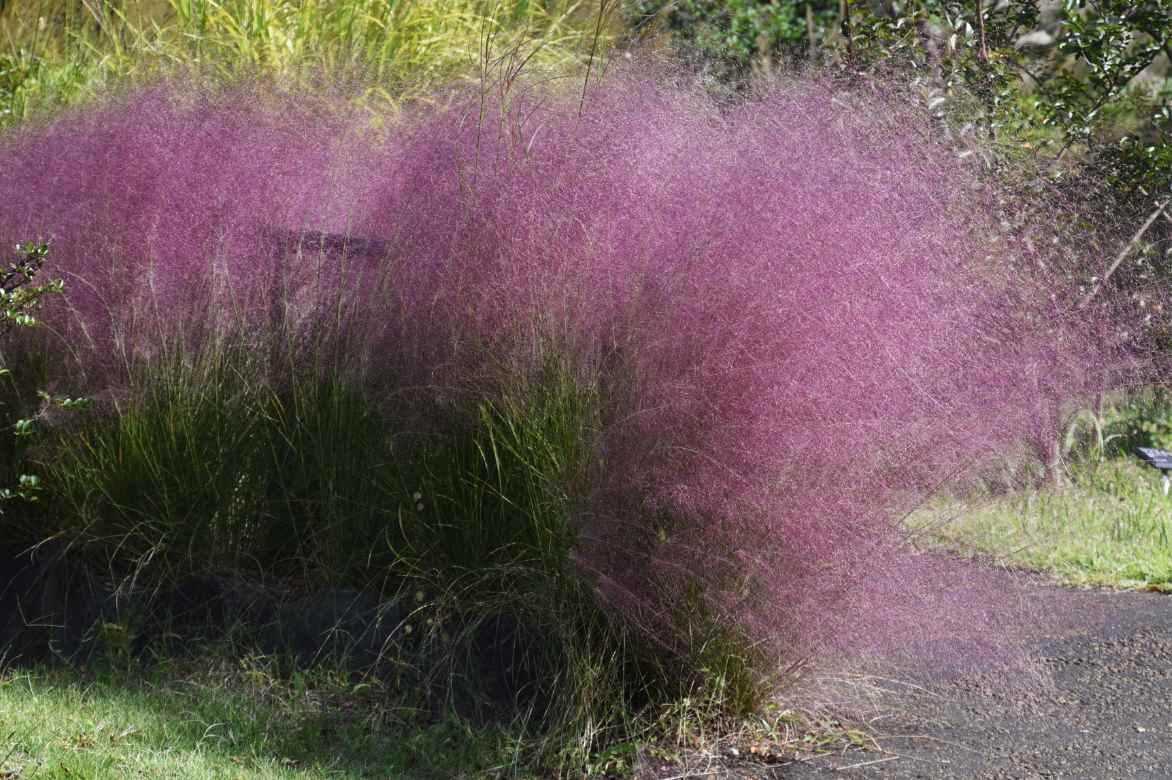
Potential Pests and Diseases
The Muhlenbergia are particularly hardy and resilient plants, and they are rarely affected by diseases or pests. However, certain situations can cause problems.
Root Rot
This can occur if the soil or pot is poorly drained, leading to an accumulation of water around the roots. Symptoms include yellowing of the leaves and slowed growth. To prevent it, ensure the soil is well-drained and avoid overwatering.
Aphids
Although rarely a major issue, they can sometimes infest young shoots. Aphids feed on the sap of the leaves, causing them to deform. A strong jet of water or a treatment with black soap can eliminate them.
Scale Insects
These insects can occasionally attack the stems or leaves, forming small white or brown bumps. Scale insects can be combated with vegetable oils and black soap.
How to propagate your Muhlenbergia?
Propagation by Sowing
Sowing is more complicated than division but allows for the multiplication of a large number of young plants at once. The characteristics (shape and colour of the plant) may vary slightly.
- Seed Harvesting: Seeds can be harvested after flowering, in autumn. Wait until the floral spikes are dry before picking them.
- Sowing Period: Sowing is generally done in spring (April-May), when temperatures begin to warm up.
- Substrate: Use a light, well-draining potting mix, ideally mixed with a bit of sand to facilitate germination.
- Sowing Depth: Sow the seeds on the surface of the soil or barely covered, as they need light to germinate.
- Conditions: Keep the substrate moist (but not waterlogged) and place the sowing in a bright spot. Germination may take 2 to 4 weeks, depending on conditions.
- Transplanting: Once the young seedlings have a few leaves and are sturdy enough, transplant them into individual pots or directly into the ground.
Propagation by Division
Division is the quickest method, especially if you want to reproduce a specific plant (same colour, same shape).
- Ideal Period: Division is preferably done in spring or autumn, when the plant is dormant.
- Preparation: Choose a well-developed clump, at least 2 or 3 years old. Carefully remove the plant from the soil using a spade, taking care not to damage the roots.
- Division: Use a sharp knife or spade to divide the clump into several sections. Each section should have several stems and a good root system.
- Replanting: Immediately replant the divisions in well-draining soil or pots, ensuring the roots are well spread out. Water generously after planting to aid rooting.
Association of Muhlenbergia
To create a harmonious bed with muhly grasses, a great idea would be to mix the pink hues of Muhlenbergia with blue flowers and a few touches of yellow, creating a striking contrast. Alternate plants with fine, airy foliage with species that have denser foliage and produce compact flowers, such as sedums. It’s also important to leave enough space around the Muhlenbergia to showcase their airy panicles and prevent them from being overwhelmed by larger plants.
In this bed, you can create a subtle harmony by playing with textures, colours, and the movement of the different plants. At the centre, Muhlenbergia capillaris, with its delicate pink, wispy inflorescences, will add a striking lightness. Around these grasses, the addition of a few clumps of Gaura lindheimeri ‘Rosy Jane’, with their pink flowers floating above the foliage, will enhance this sense of softness and movement.
To structure the arrangement, the inclusion of 4 or 5 Echinacea purpurea ‘Summer Cocktail’ will provide an interesting contrast with their large purple flowers and orange centres, adding a more solid touch. Beside them, Hylotelephium spectabile ‘Autumn Joy’, with their fleshy pink inflorescences, will add volume and visual stability while balancing the lightness of the other species.
Finally, Verbena bonariensis ‘Lollipop’, with their slender, airy stems topped with small mauve flowers, will harmonise perfectly with Coreopsis verticillata ‘Zagreb’, whose bright yellow flowers will add luminous touches and attract pollinators.
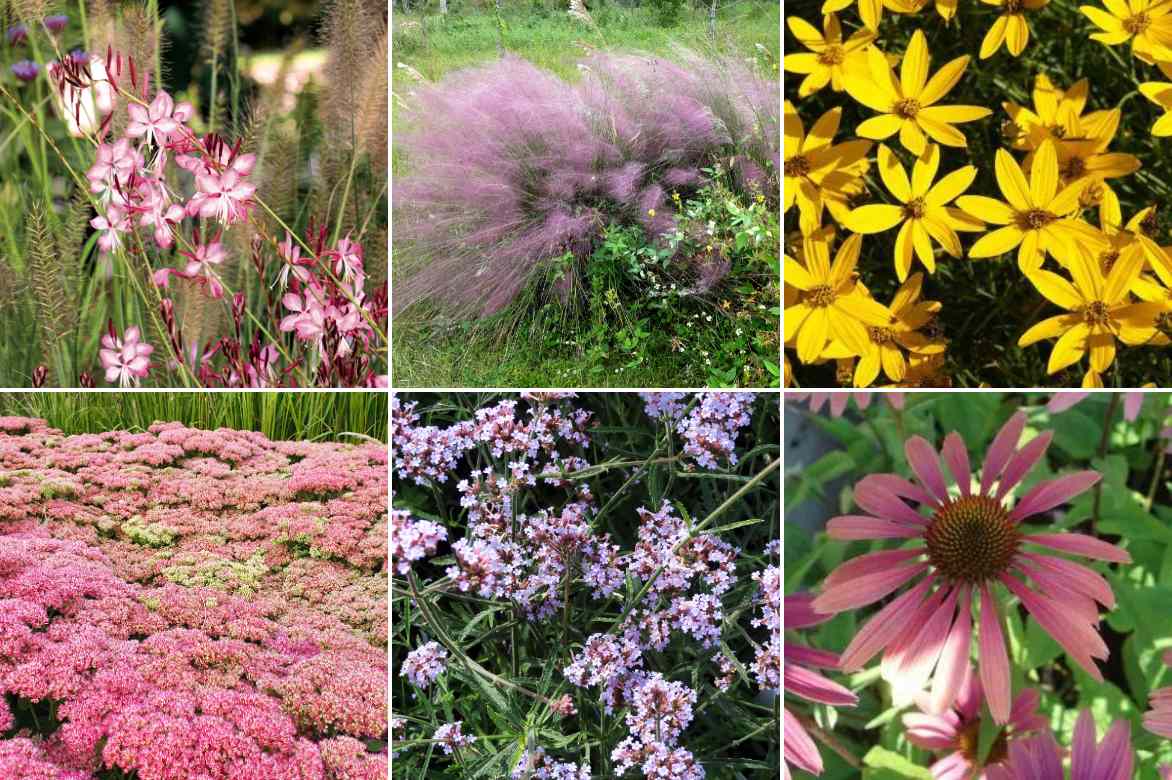
Gaura ‘Rosy Jane’, Muhlenbergia capillaris, Coreopsis verticillata ‘Zagreb’, Stonecrop ‘Autumn Joy’, Buenos Aires Verbena ‘Lollipop’, and Purple Coneflower ‘Summer Cocktail’
Also worth reading
If you are fascinated by Muhlenbergia and wish to deepen your knowledge about these magnificent ornamental grasses or discover other plants suited to dry and sunny gardens, the Promesse de Fleurs website offers numerous articles to guide you in selecting and caring for ornamental grasses and drought-resistant plants.
→ To learn more, check out articles like “10 ornamental grasses you must have in your garden” or “5 perennial ground covers for dry soil“.
- Subscribe!
- Contents
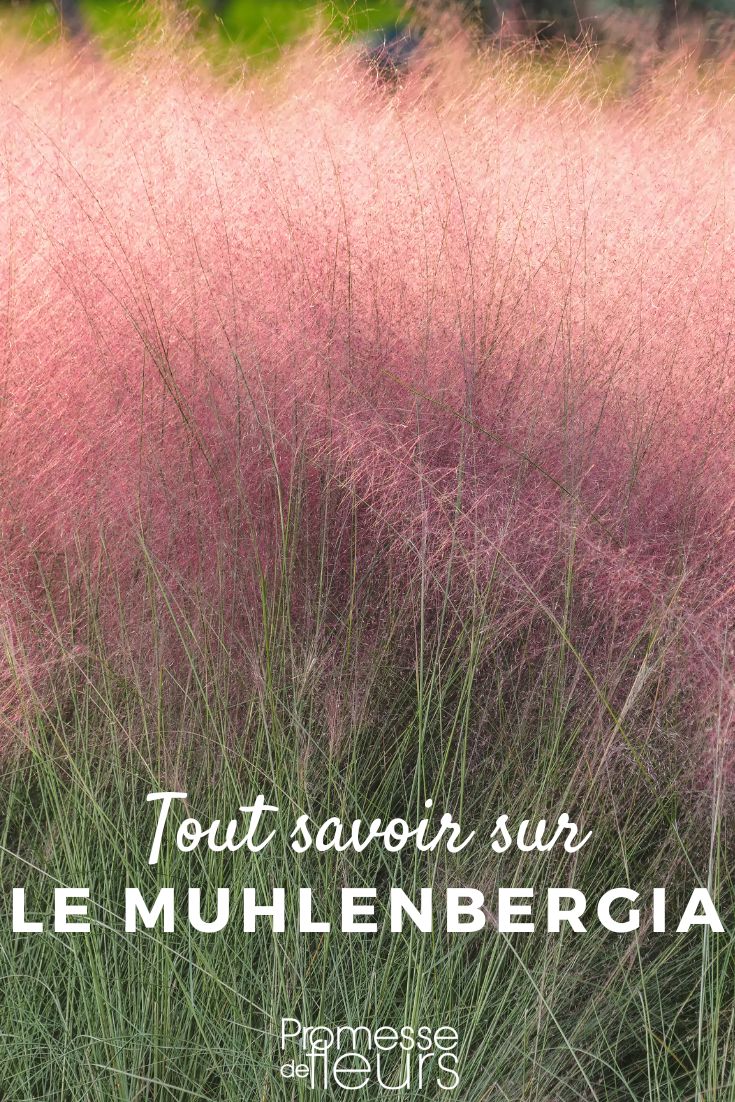































Comments